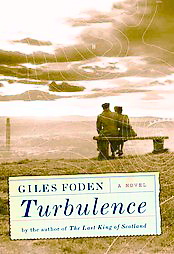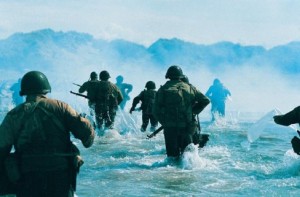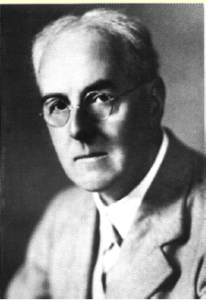Note: Giles Foden was WINNER of the James Tait Black Memorial Prize, WINNER of the Whitbread First Novel Award, and WINNER of the Betty Trask Award in 1998-99 for The Last King of Scotland.
“There are no accidents. Every so-called ‘accident,’ every piece of turbulence, is part of a sequence, bigger or smaller, whose scale you cannot see. At least, you don’t see it until it’s too late, and then you start to panic, beause you realize how foolish was your original fantasy of understanding.”
 How long has it been since you have read a novel with a thematic line so unusual and so well explicated that reading the book changed your way of seeing the world? This novel was one such experience for me. Metaphysical, historical, and utterly different from anything I have ever read, Giles Foden’s Turbulence kept me (neither a mathematician nor a student of physics) turning the pages, no matter how theoretical and dense the novel sometimes became with its science. Fascinating personal stories are interwoven with the scientific plot, giving the novel immediacy, even for a devout non-scientist.
How long has it been since you have read a novel with a thematic line so unusual and so well explicated that reading the book changed your way of seeing the world? This novel was one such experience for me. Metaphysical, historical, and utterly different from anything I have ever read, Giles Foden’s Turbulence kept me (neither a mathematician nor a student of physics) turning the pages, no matter how theoretical and dense the novel sometimes became with its science. Fascinating personal stories are interwoven with the scientific plot, giving the novel immediacy, even for a devout non-scientist.
Set in London and Scotland from January through June, 1944, the novel is a study of weather forecasting and all the factors which must be considered in making long-range predictions. Henry Meadows, a young academician at Cambridge with a doctorate in mathematics/physics, has written his thesis on fluid dynamics, focusing on the idea of turbulence and other complex flows which move constantly, are difficult to quantify, and have unpredictable effects on other physical measurements. Though he might have remained in his lab at the university forever, he wants to do something for Britain’s war effort, and when he sees an advertisement for a training post in the Meteorological Office, he applies, is accepted for the Central Forecasting Unit, and is eventually sent to Scotland. His job is to observe and eventually help forecast weather patterns over a five-day period for fifty miles of German-occupied French coastline so that an invasion can be planned and a window of opportunity identified for D-Day.
physical measurements. Though he might have remained in his lab at the university forever, he wants to do something for Britain’s war effort, and when he sees an advertisement for a training post in the Meteorological Office, he applies, is accepted for the Central Forecasting Unit, and is eventually sent to Scotland. His job is to observe and eventually help forecast weather patterns over a five-day period for fifty miles of German-occupied French coastline so that an invasion can be planned and a window of opportunity identified for D-Day.
The task will eventually involve the US under Gen. Eisenhower, the RAF, the Royal Navy, and the Met office and will require the establishment of a network of several hundred weather stations on land and sea, spanning a distance of twelve-hundred miles from Iceland to England. Each of these stations will report by telegraph to a central facility. Forecasting at this time is inexact, however, with accuracy declining for every day after the first day of observations. Forecasts beyond two or three days are often wildly inaccurate, and a five-day forecast seems impossible. Though the air pressure, the winds, and the temperatures can all be measured, these measurements can be compromised, sometimes fatally, by the unexpected effects of turbulence and by measurements which may not be completely exact. Discovering some valid way to add turbulence into the calculations would help explain the seemingly random changes which occur in the weather, a crucial element in the D-Day plans.
Over 2.5 million men and t hree thousand landing craft are depending on the accuracy of the forecast. The Germans are expecting an invasion, and Allied surprise and ultimate success depend on finding a window which the Germans will not also foresee. Only one person has found a way to deal with this kind of turbulence and its effects on forecasting—Wallace Ryman, a famed mathematical researcher who is also a pacifist. Henry Meadows hopes to convince him to share the application of his “Ryman number” in the pursuit of a weather equation to aid in meteorological forecasting.
hree thousand landing craft are depending on the accuracy of the forecast. The Germans are expecting an invasion, and Allied surprise and ultimate success depend on finding a window which the Germans will not also foresee. Only one person has found a way to deal with this kind of turbulence and its effects on forecasting—Wallace Ryman, a famed mathematical researcher who is also a pacifist. Henry Meadows hopes to convince him to share the application of his “Ryman number” in the pursuit of a weather equation to aid in meteorological forecasting.
Foden uses real people as his models for the characters in the novel. Main character Wallace Ryman is the fictional equivalent of a real man, Henry Fry Richardson, whose real life paralleled that of Ryman in virtually every way, and the other named characters (including Geoffrey Pyke and Sverre Petterssen) are real. The novel has been fully researched, and, though it is fictional, the con cepts behind it have actual bases in reality and science. Where the novel may raise some questions for some people is in the subplots. Some “researchers” in the novel believe that the formula for dealing with turbulence in the weather can also be applied to problems in sociological and interpersonal relationships—from the tendency of countries to go to war to the disagreements among lovers. This makes the subplots seem sensational and unrealistic, at times, an attempt to show that turbulence is responsible for the random events which affect the personal lives of the characters, an attempt also to show that “random” events may not be random at all.
cepts behind it have actual bases in reality and science. Where the novel may raise some questions for some people is in the subplots. Some “researchers” in the novel believe that the formula for dealing with turbulence in the weather can also be applied to problems in sociological and interpersonal relationships—from the tendency of countries to go to war to the disagreements among lovers. This makes the subplots seem sensational and unrealistic, at times, an attempt to show that turbulence is responsible for the random events which affect the personal lives of the characters, an attempt also to show that “random” events may not be random at all.
The main character, Henry Meadows, is not fully developed, and his excessive use of alcohol blurs the opinions one might otherwise have of him. His early life on a tobacco farm in Nyasaland, the history of weather forecasting, the opinions of the cleric with whom Ryman argues about the interpretation of God’s will, the issues of science which have not yet been resolved (a solution for the problems of the Rh factor, for example), and the desire to find one formula which will explain the as yet unexplainable future, all relate to the idea of turbulence but do not necessarily provide insights or answers. Filled with vibrant descriptions, an assortment of characters whose views of the world differ greatly from that of the twenty-first century, a setting that reflects a critical moment in time, and philosophical/scientific themes and insights of great originality, Turbulence is a novel which manages to raise questions and explore them in ways not seen before in literary fiction, and I loved it.
Photos, in order: The author’s photo is from www.faber.co.uk
The photo of Henry Fry Richardson appears on Wiki: http://en.wikipedia.org/wiki
The D-Day photo appears on www.theodoresworld.net
Notes: For those interested in the science and math behind the “Ryman number,” which is really the “Richardson number,” please see: http://en.wikipedia.org for a complete discussion.
Geoffrey Pyke’s bio is also on Wiki: http://en.wikipedia.org
